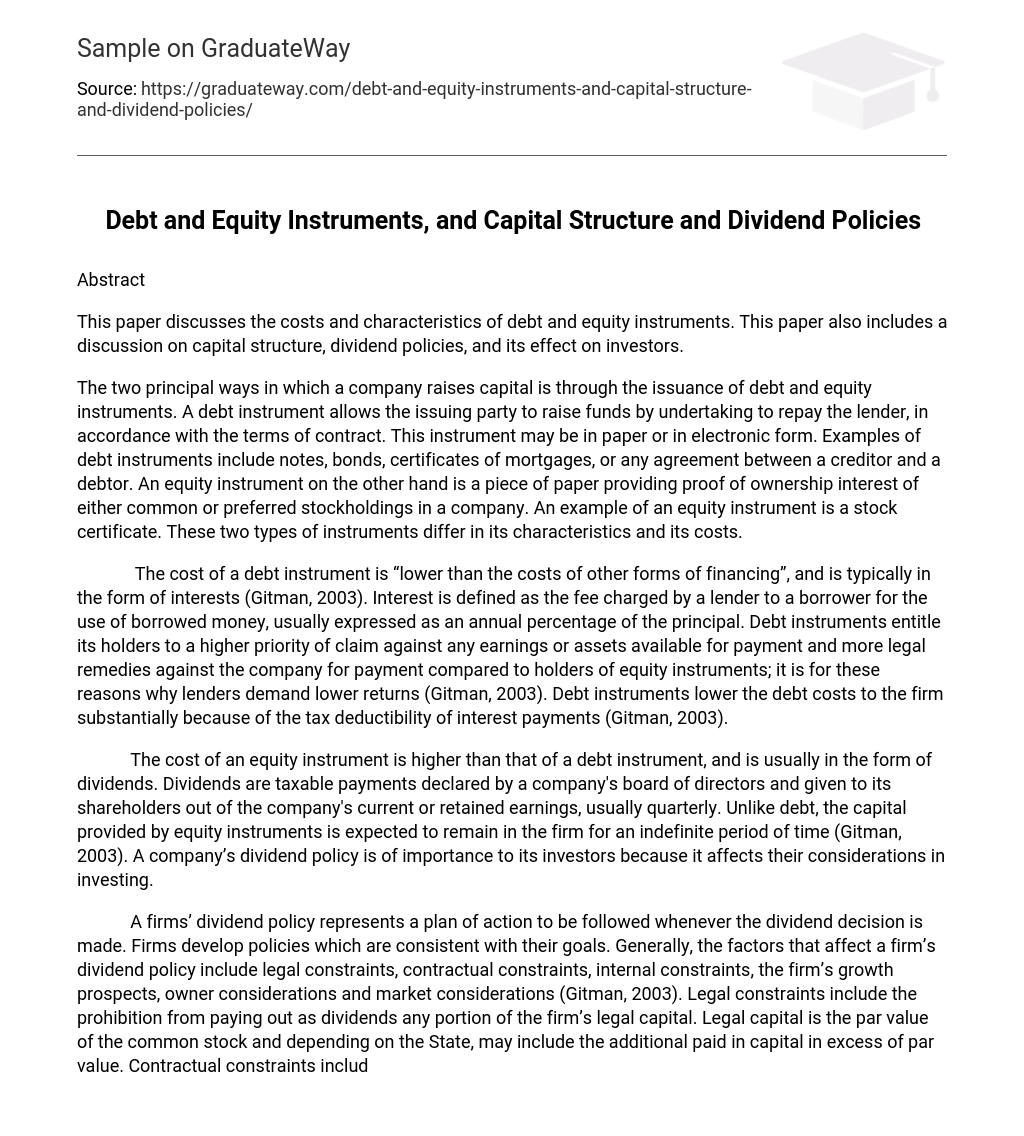Abstract
This paper discusses the costs and characteristics of debt and equity instruments. This paper also includes a discussion on capital structure, dividend policies, and its effect on investors.
The two principal ways in which a company raises capital is through the issuance of debt and equity instruments. A debt instrument allows the issuing party to raise funds by undertaking to repay the lender, in accordance with the terms of contract. This instrument may be in paper or in electronic form. Examples of debt instruments include notes, bonds, certificates of mortgages, or any agreement between a creditor and a debtor. An equity instrument on the other hand is a piece of paper providing proof of ownership interest of either common or preferred stockholdings in a company. An example of an equity instrument is a stock certificate. These two types of instruments differ in its characteristics and its costs.
The cost of a debt instrument is “lower than the costs of other forms of financing”, and is typically in the form of interests (Gitman, 2003). Interest is defined as the fee charged by a lender to a borrower for the use of borrowed money, usually expressed as an annual percentage of the principal. Debt instruments entitle its holders to a higher priority of claim against any earnings or assets available for payment and more legal remedies against the company for payment compared to holders of equity instruments; it is for these reasons why lenders demand lower returns (Gitman, 2003). Debt instruments lower the debt costs to the firm substantially because of the tax deductibility of interest payments (Gitman, 2003).
The cost of an equity instrument is higher than that of a debt instrument, and is usually in the form of dividends. Dividends are taxable payments declared by a company’s board of directors and given to its shareholders out of the company’s current or retained earnings, usually quarterly. Unlike debt, the capital provided by equity instruments is expected to remain in the firm for an indefinite period of time (Gitman, 2003). A company’s dividend policy is of importance to its investors because it affects their considerations in investing.
A firms’ dividend policy represents a plan of action to be followed whenever the dividend decision is made. Firms develop policies which are consistent with their goals. Generally, the factors that affect a firm’s dividend policy include legal constraints, contractual constraints, internal constraints, the firm’s growth prospects, owner considerations and market considerations (Gitman, 2003). Legal constraints include the prohibition from paying out as dividends any portion of the firm’s legal capital. Legal capital is the par value of the common stock and depending on the State, may include the additional paid in capital in excess of par value. Contractual constraints include restrictive provisions in a loan agreement designed to help protect creditors from losses due to the firm’s insolvency. The firm’s ability to pay cash dividends is generally constrained by the amount of liquid assets available, an internal constraint on its dividend policy. Growth prospects affect the firm’s dividend policy because it dictates the financial requirements of the company. Owner considerations also influence companies in developing its dividend policies because they need to establish one that has a favorable effect on the wealth of majority of its owners. The market’s probable response to certain types of policies is also especially helpful in formulating dividend policies. The three basic types of dividend policies are the constant-payout-ratio, where the firm pays a fixed percentage of earnings to owners each period; the regular dividend policy where the firm pays a fixed dollar dividend each period; and the low- regular-and-extra dividend policy which is similar to the regular, except that it pays extra dividends when the firm’s earnings are higher than normal. Of these policies, the regular and the low-regular-and-extra dividend policies are preferred because their stable patterns reduce uncertainty (Gitman, 2003). However, it is ultimately up to the investor. If he prefers to take greater risk then he would favor the constant-payout-ratio, in which level of dividends fluctuate with the company’s earnings.
Investors not only look at the company’s dividend policy, but also at the debt-equity mix. Debt-equity mix, also known as the capital structure, is the mix of long-term debt and equity maintained by the firm. Investor assesses the capital structure to determine a company’s financial leverage. Financial leverage is the potential use of fixed financial costs to magnify the effects of changes in earnings before interest and taxes on the firm’s earnings per share. Financial leverage is a double-edged sword, which may be positive or negative; its common measures are the debt ratio, the times-interest earned and the fixed-payment coverage ratios (Garrison, 2000). The company can utilize leverage to maximize the return on its investments. The appropriate degree of leverage would depend on the industry to which the company belongs, among other things. A company with a positive financial leverage seems like a good investment for promises a bigger return on one’s investment.
References
Garrison, R.H., & Noreen, E.W. (2000). Managerial Accounting. USA: The McGraw-Hill Companies, Inc.
Gitman, Lawrence J. (2003). Principles of Managerial Finance. Singapore: Pearson Education (Asia) PTE Ltd.





